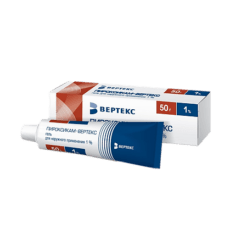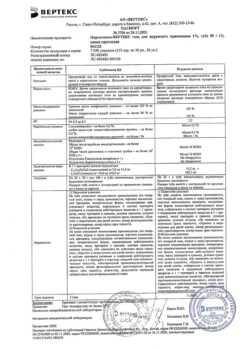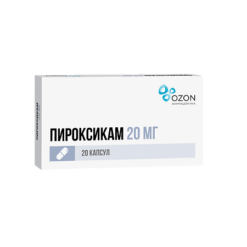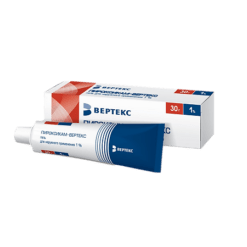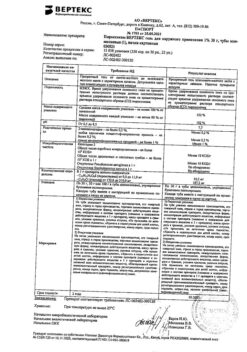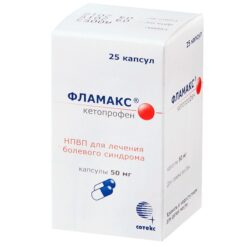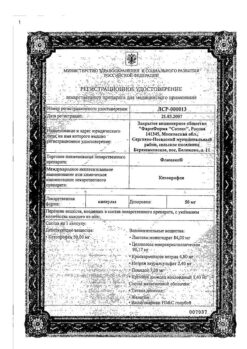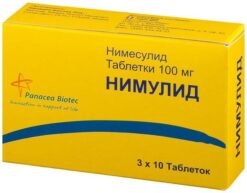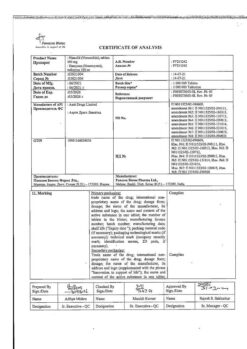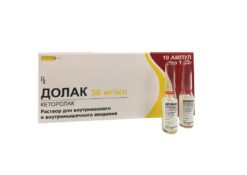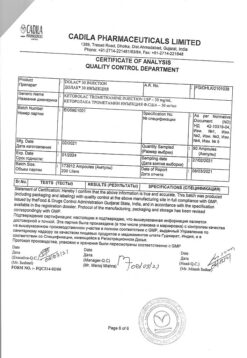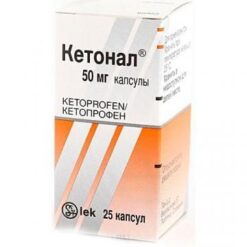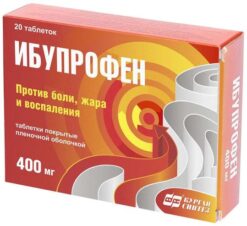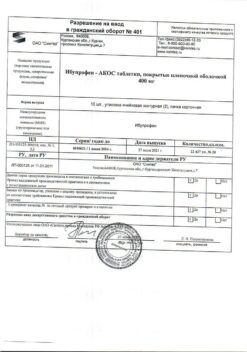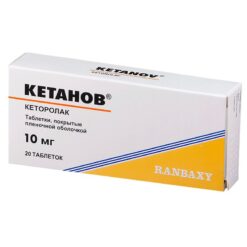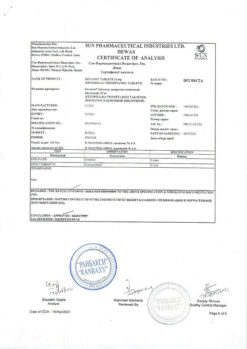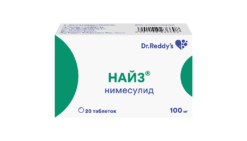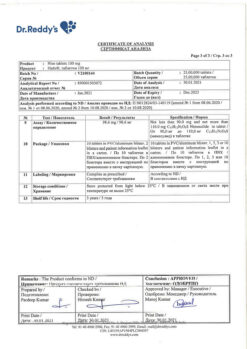No products in the cart.
Piroxicam, 10 mg capsules 20 pcs
€6.22 €5.53
Description
Pharmacotherapeutic group: Non-steroidal anti-inflammatory drug (NSAIDs)
ATC code: M02AA07
Pharmacodynamics:
Pyroxicam is a nonsteroidal anti-inflammatory drug (NSAID) with anti-inflammatory analgesic and antipyretic effects.
Nonselectively inhibits activity of cyclooxygenase 1 and cyclooxygenase 2 (COX1 and COX2) inhibits synthesis of prostaglandins in the inflammation focus and central nervous system, suppresses exudative and proliferative phases of inflammation. Inhibits the aggregation of neutrophils and the formation of superoxide anions in them the migration of polymorphonuclear cells and monocytes to the inflammation focus. Reduces the release of lysosomal enzymes from stimulated leukocytes. Reduces pyrogenic effect of prostaglandins on the thermoregulation center. Reduces the severity of pain syndrome of moderate intensity by increasing the threshold of pain sensitivity to biological amines. Analgesic effect appears 30 min after oral administration. After single use the effect lasts for 24 hours.
In joint syndrome, it reduces or kills inflammation and pain at rest when moving reduces morning stiffness and swelling of the joints helps increase the amount of movement. In algodysmenorrhea (as an inhibitor of prostaglandin synthesis in the endometrium) it relieves the pain syndrome.
Pharmacokinetics:
When taken orally, the drug is well absorbed from the gastrointestinal tract and the maximum concentration in plasma is proportional to the dose used. Maximum plasma concentrations are reached 3-5 hours after oral administration. After a single dose of 20 mg, Cmax is 15-2 mcg/ml after regular administration of 20 mg/day – 3-8 mcg/ml. Food slows down the rate of absorption but does not affect the volume of absorption. Bioavailability is almost 100%. Time to reach equilibrium concentration is 7-12 days. It penetrates into the synovial fluid (40-50 %) is excreted with the breast milk – 1-3 %. It easily binds with blood plasma proteins (almost 98 %).
The elimination half-life is 24-50 h in liver disease may be prolonged. The drug is metabolized in liver through hydroxylation of pyridine ring of side chain with subsequent conjugation with glucuronic acid and formation of inactive metabolites. It is excreted as conjugates by the kidneys and, to a lesser extent, through the intestines. About 5% is excreted unchanged.
Indications
Indications
Diseases of the musculoskeletal system: rheumatoid arthritis osteoarthritis spondylitis sciatica psoriatic arthropathy gout tendovaginitis bursitis ankylosing spondylitis (ankylosing spondylitis) pain in the spine neuralgia myalgia postoperative and post-traumatic pain extra-articular rheumatic diseases soft tissue inflammation. Algodismenorrhea.
Intended for symptomatic therapy to reduce pain and inflammation at the time of use, it does not affect the progression of the disease.
Pharmacological effect
Pharmacological effect
Pharmacotherapeutic group: Non-steroidal anti-inflammatory drug (NSAID)
ATX code: M02AA07
Pharmacodynamics:
Piroxicam is a non-steroidal anti-inflammatory drug (NSAID) with anti-inflammatory analgesic and antipyretic effects.
Non-selectively suppresses the activity of cyclooxygenase 1 and cyclooxygenase 2 (COX1 and COX2), inhibits the synthesis of prostaglandins at the site of inflammation and suppresses the exudative and proliferative phase of inflammation in the central nervous system. Inhibits the aggregation of neutrophils and the formation of superoxide anions in them, the migration of polymorphonuclear cells and monocytes to the site of inflammation. Reduces the release of lysosomal enzymes from stimulated leukocytes. Reduces the pyrogenic effect of prostaglandins on the thermoregulation center. Reduces the severity of pain of moderate intensity by increasing the threshold of pain sensitivity to biological amines. The analgesic effect appears 30 minutes after oral administration. After a single dose, the effect lasts for 24 hours.
In case of articular syndrome, it weakens or stops inflammation and pain at rest when moving, reduces morning stiffness and swelling of the joints, helps to increase the range of movements. In case of algodismenorrhea (being an inhibitor of prostaglandin synthesis in the endometrium) it relieves pain.
Pharmacokinetics:
When taken orally, the drug is well absorbed from the gastrointestinal tract; the maximum plasma concentration is proportional to the dose used. The maximum concentration in plasma is achieved 3-5 hours after taking the drug orally. After a single dose of 20 mg Cmax – 15-2 mcg/ml after regular use of 20 mg/day – 3-8 mcg/ml. Food slows down the rate of absorption but does not affect the amount absorbed. Bioavailability is almost 100%. The time to reach equilibrium concentration is 7-12 days. Penetrates into synovial fluid (40-50%) and is excreted in breast milk – 1-3%. Easily binds to blood plasma proteins (almost 98%).
The half-life is 24-50 hours and may be prolonged in case of liver disease. The drug is metabolized in the liver through hydroxylation of the side chain pyridine ring, followed by conjugation with glucuronic acid and the formation of inactive metabolites. It is excreted in the form of conjugates by the kidneys and, to a lesser extent, through the intestines. About 5% is excreted unchanged.
Special instructions
Special instructions
To prevent unwanted effects, the drug should be used only as prescribed by a doctor in the minimum effective dose in the shortest possible short course.
The simultaneous use of several non-steroidal anti-inflammatory drugs increases the risk of side effects, while the therapeutic effect does not improve.
The drug may change the properties of platelets; however, it does not replace the preventive effect of acetylsalicylic acid in cardiovascular diseases.
With extreme caution, the drug should be prescribed to patients with impaired liver or kidney function who use diuretics after extensive surgical interventions in old age. Such patients need to monitor the cellular composition of the blood and kidney function.
After 2 weeks of using the drug, monitoring of liver function indicators (transaminases) is necessary.
To reduce the risk of developing adverse events from the gastrointestinal tract, the minimum effective dose should be used in the shortest possible short course.
If during drug therapy the patient develops signs of an ulcer in the gastrointestinal tract, then treatment must be interrupted; if the use of the drug is absolutely necessary, then treatment should be carried out under the supervision of a doctor with the simultaneous use of antacids.
It is not recommended to prescribe the drug to patients with bronchial asthma, allergic rhinitis, polyps of the nasal mucosa, as well as chronic obstructive respiratory diseases.
The use of the drug may adversely affect female fertility and is not recommended for women planning pregnancy.
During treatment with the drug, alcohol consumption is prohibited.
Recommendations for use in children under 15 years of age have not yet been developed.
Impact on the ability to drive vehicles. Wed and fur.:
During the treatment period, care must be taken when driving vehicles and engaging in other potentially hazardous activities that require increased concentration and speed of psychomotor reactions.
Active ingredient
Active ingredient
Piroxicam
Composition
Composition
Composition per capsule:
Piroxicam (in terms of 100% substance) – 10 mg.
Excipients: – microcrystalline cellulose, potato starch, talc, colloidal silicon dioxide. Hard gelatin capsules: gelatin, titanium dioxide, yellow iron oxide, indigo carmine, water.
Contraindications
Contraindications
hypersensitivity to piroxicam and other non-steroidal anti-inflammatory drugs to components of the drug;
complete or incomplete combination of bronchial asthma, recurrent polyposis of the nasal mucosa or paranasal sinuses and intolerance to acetylsalicylic acid and other NSAIDs (including history);
erosive and ulcerative changes in the mucous membrane of the stomach or duodenum; active gastrointestinal bleeding; cerebrovascular or other bleeding;
inflammatory bowel diseases (Crohn’s disease, ulcerative colitis) in the acute phase;
hemophilia and other bleeding disorders;
decompensated heart failure;
liver failure or any active liver disease;
severe renal failure (creatinine clearance less than 30 ml/min) progressive kidney disease confirmed hyperkalemia;
period after coronary artery bypass surgery;
pregnancy, breastfeeding period;
children under 15 years of age.
With caution:
age over 65 years;
coronary heart disease cerebrovascular diseases congestive
heart failure;
dyslipidemia/hyperlipidemia;
arterial hypertension;
diabetes mellitus;
peripheral arterial disease;
bronchial asthma;
presence of hepatic porphyria;
creatinine clearance from 30-60 ml/min;
postoperative period;
dehydration;
smoking;
anamnestic data on the development of ulcerative lesions of the gastrointestinal tract, the presence of Helicobacter pylori infection, long-term use of NSAIDs, frequent alcohol consumption, severe somatic diseases, concomitant therapy with the following drugs:
– anticoagulants (for example warfarin);
– antiplatelet agents (for example acetylsalicylic acid clopidogrel);
– oral glucocorticosteroids (for example prednisolone);
– selective serotonin reuptake inhibitors (for example, citalopram fluoxetine paroxetine sertraline).
Side Effects
Side Effects
The most common manifestations are from the gastrointestinal tract and digestive organs: pain in the epigastric region belching nausea loss of appetite vomiting constipation or diarrhea flatulence erosive and ulcerative lesions of the gastrointestinal tract bleeding in the gastrointestinal tract which in exceptional cases can cause anemia perforation of the gastrointestinal tract; dry mouth, stomatitis.
From the hepatobiliary system: liver dysfunction, increased activity of “liver” transaminases; increased concentrations of nitrogen and creatinine in plasma.
From the urinary system: impaired renal function, interstitial nephritis, papillary necrosis, nephrotic syndrome, erythrocyturia, proteinuria, hyper- or hypokalemia, glomerulonephritis, nephrosis.
From the central nervous system: dizziness headache tinnitus drowsiness insomnia less often – depression irritability hallucinations paresthesia lethargy changes in mood.
From the hematopoietic and hemostasis system: anemia, including aplastic and hemolytic, decreased hemoglobin, decreased hematocrit; leukopenia, eosinophilia, rarely – thrombocytopenia, hemorrhages, thrombocytopenic purpura (Henoch-Schönlein disease); suppression of bone marrow function.
From the cardiovascular system: increase or decrease in blood pressure, signs of heart failure rarely – palpitations, shortness of breath.
Allergic reactions: skin rash itching erythema reactions photosensitivity Lyell’s syndrome facial swelling of the larynx bronchospasm malignant exudative erythema (Stevens-Johnson syndrome) anaphylactic shock vasculitis serum sickness.
Other: blurred vision, swelling of the legs and feet, increased sweating, increased urea concentration; increase or decrease in body weight.
The frequency of the above disorders increases with increasing daily dose of the drug.
Interaction
Interaction
With simultaneous use of piroxicam and:
glucocorticosteroids and/or NSAIDs – increases the risk of side effects from the gastrointestinal tract, including bleeding;
phenobarbital – the level of concentration of piroxicam in the blood serum decreases;
cimetidine probenecid and sulfinpyrazone – the concentration of piroxicam in the blood serum may increase, which leads to increased side effects of piroxicam;
phenytoin and/or lithium as well as potassium-sparing diuretics and K+ donors – the plasma concentrations of phenytoin lithium and potassium may increase;
diuretics and antihypertensive drugs – the effect of the latter is weakened;
anticoagulants – the ability of platelets to aggregate decreases (risk of bleeding); it is necessary to control blood clotting;
acetylsalicylic acid – the concentration of piroxicam in the blood serum decreases, the risk of developing erosive and ulcerative lesions of the gastrointestinal tract increases;
selective serotonin reuptake inhibitors (citalopram fluoxetine paroxetine sertraline) increase the risk of developing erosive and ulcerative lesions of the gastrointestinal tract;
methotrexate – can lead to an increase in the concentration of methotrexate and an increase in its toxic effect.
Overdose
Overdose
Symptoms: abdominal pain nausea vomiting drowsiness blurred vision when taking very large doses – loss of consciousness coma.
Treatment: gastric lavage using activated charcoal to slow down absorption, antacids are used.
In case of severe poisoning, the patient should be hospitalized. There is no specific antidote.
Treatment is symptomatic.
Storage conditions
Storage conditions
Store in a dry place, protected from light, out of reach of children, at a temperature not exceeding 25C.
Shelf life
Shelf life
2 years. Do not use after the expiration date indicated on the package.
Manufacturer
Manufacturer
Ozon, Russia
Additional information
| Shelf life | 2 years. Do not use after the expiration date stated on the package. |
|---|---|
| Conditions of storage | Store in a dry place out of the reach of children at temperatures under 25C. |
| Manufacturer | Ozon, Russia |
| Medication form | capsules |
| Brand | Ozon |
Other forms…
Related products
Buy Piroxicam, 10 mg capsules 20 pcs with delivery to USA, UK, Europe and over 120 other countries.


